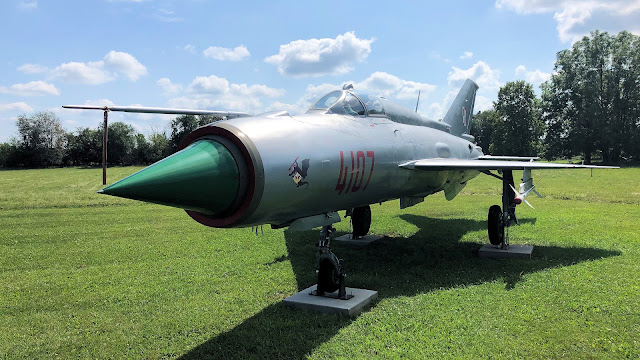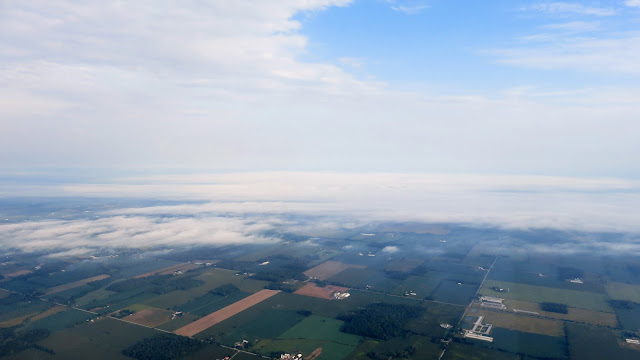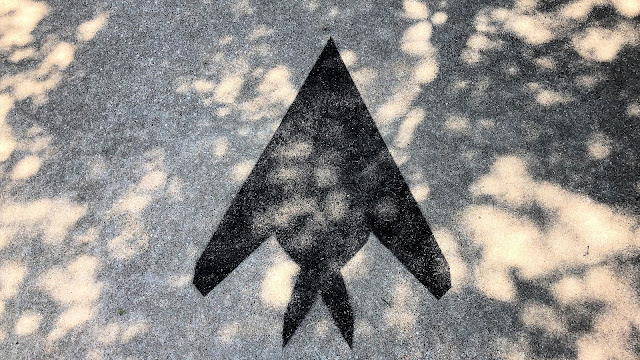Opportunity Knocks
On 02 June 2021, I received an intriguing note from the Air Zoo in Kalamazoo, MI:
"Hi Chris...I want to offer you the opportunity to also participate in a restoration project as a special thank you for your support. The experience will allow you to join our restoration team to work on Shaba [the Air Zoo's recently acquired F-117 stealth fighter]."
 |
| The Lockheed F-117 Nighthawk Shaba shortly after arrival at the Air Zoo. Photo by the Air Zoo. |
Put mildly, my interest was piqued.
Hopeless Diamond
Sometimes, a flair for the dramatic is the best way to get someone's attention. There is a moment in the book Skunk Works -- Ben Rich's memoir of his time working in and eventually leading Lockheed's black project development division -- where the author rolls a ball bearing across an Air Force general's desk and explains that it is equivalent to the radar cross section of his new airplane.
The stealth fighter project, code-named Have Blue, was a tremendous leap for an organization that was already lionized for innovation in building untouchable aircraft. Their U-2 spy plane was designed to fly so high (70,000 feet) that it was effectively out of reach from other aircraft and ordnance. (Until it wasn't.) Their next untouchable design was the SR-71 Blackbird spy plane and variants like the A-12; somewhat stealthy, but possessed of speed (Mach 3.2) and altitude (85,000 feet) capability that allowed it to fly anywhere in the world with impunity. But the stealth fighter was an entirely new paradigm. It would not be untouchable because of speed or altitude, but because it was incredibly difficult to detect by radar.
From the beginning, Have Blue presented as an oddly faceted arrowhead shape dubbed the "Hopeless Diamond" by its Lockheed designer, Denys Overholser. Designed to reflect radar energy anywhere but back toward the originating station, there is not a rounded surface or a right angle anywhere on the aircraft. Stealth technology was based on the revolutionary idea that radar cross sections are not a function of aircraft size as previously thought, but aircraft shape. Although pilots later praised its flying qualities, the design broke so many aerodynamic rules in the name of stealth that a human being could have never manually controlled it. Instead, pilot input was reinterpreted by a computer that drove impulses to each aerodynamic surface to ensure controllable flight. This system was not perfected in the original pair of Have Blue test beds and pilots nicknamed them "Wobblin' Goblins".
During evaluation, the radar cross section of the Have Blue demonstrator was so small that the radar signature of the pole carrying the model was actually significant. Rumors that Lockheed was somehow gaming the radar cross section results led to an MIT radar expert being dispatched to the test site where he proceeded to attach ball bearings of varying diameters to the nose of the aircraft. A ball bearing of 1/8 inch diameter could still be differentiated against the radar background of the aircraft, an observation that inspired Ben Rich's theatrics with the Air Force brass.
 |
| Public domain USAF photo of the F-117 Nighthawk in flight. |
This effort eventually led to the F-117A Nighthawk stealth fighter, a program so secret that security measures rivaled those of the Manhattan Project. Though operational since 1983, stealth fighters are most commonly associated with 1991's Gulf War where the aircraft flew 1300 sorties over Iraq. Although the aircraft was called a "fighter", it was really a ground attack aircraft equipped with two laser-guided bombs intended for precision strikes.
In total, sixty four Nighthawks were built and the fleet was officially retired in 2008, though there have been some sightings of airborne 117s in the years since. More recently, some have found their way into museums. My beloved Air Zoo in Kalamazoo, MI became a rare non-government affiliated museum to acquire one in December of 2020. The Air Zoo's Nighthawk is named Shaba, a Saudi nickname for the aircraft that translates to "ghost" in Arabic.
Get Shaba
It was a coup for the Air Zoo to earn the privilege of displaying this aircraft. And they needed financial help, so I contributed. Although my passion has always been for the piston-powered aircraft of WWII, the F-117 is a truly rare and noteworthy addition to the collection.
I was utterly surprised when the invitation came to visit Kalamazoo and participate in the restoration effort in a hands-on way. Even if it was to be a token amount of work, I would not have refused that invitation for anything.
Canadian Climate and Lousy Radar
| Date | Aircraft | Route of Flight | Time (hrs) | Total (hrs) |
| 25 Aug 2021 | N21481 | SDC (Sodus, NY) - AZO (Kalamazoo, MI) | 4.3 | 2338.8 |
I expected a milk run flight across Canada, but got something slightly more...interesting...instead.
A line of cells began to pop near London, ON. I asked Toronto Center what they were painting on their real time radar only to be told, "My radar is not very good." He suggested I call Canada's version of Flight Service to get their take on the conditions. This was a disconcerting comment because Toronto Center has helped steer me around cells in the past.
Fortunately, I was able to stay visual enough to confirm that I was not about to blunder into a thunderstorm cell, though I certainly threaded between a pair of them. Coincidentally, I did so without even changing course.
Despite the nervous anticipation that came with passing through a wall of weather, the actual experience was trivial and, within minutes, I emerged from the line with neither my airplane nor my spirits dampened.
Two parallel lines of cloud over the Lake Erie shore certainly caught my eye, but their course was parallel to mine and they had no bearing on my flight.
On reaching the St Clair River, I returned to US airspace and the region of my childhood.
A lone freighter made its way downriver from Lake Huron toward Lake St Clair.
 |
| The always-photogenic outlet of the St Clair River into Lake St Clair. |
 |
| Michigan shore of Lake St Clair and Selfridge ANGB |
 |
| Selfridge ANGB |
 |
| Military transport planes on the ramp at Selfridge ANGB |
I almost failed to notice it. The Summit Place (née, Pontiac Mall) had been wiped from the Earth when I wasn't looking. After all these years, Waterford's great zombie mall had ceased to exist, finally put out of its misery. I have a lot of memories in that mall.
 |
| Cass Lake and Orchard Lake near my home town. |
 |
| On approach to Kalamazoo. |
 |
| Overflying Gull Lake on approach to Kalamazoo |
Just Like Old Times
Kent met me at Duncan Aviation. Every time we meet at Duncan, I reflect back on the winter of 20 years ago when we took our ground school classes there. We enjoyed an excellent lunch of Erbelli's Original Calzones. Erbelli's has significantly broadened their calzone offerings since the old days, but the original is not only delicious, it comes fortified with nostalgia.
Kent dropped me off at the Air Zoo in time for my 1:00 appointment with Shaba. Even though I already knew where to go, there were convenient guide markers along the way.
The original Air Zoo building where I first began giving tours 20 years ago now hosts both display aircraft and the museum's restoration program. I had to smile at the old sign featuring the former museum logo still adorning the outside wall.
Demilitarized
Once inside, I was introduced to Dick Klass, the head of Shaba's restoration effort. Dick is ex-Air Force, a former F-104 Starfighter crew chief. (Coincidentally, there is an F-104 parked right next to the Nighthawk.) He proceeded to explain his strategy for restoration of the stealth fighter.
Shaba's demilitarization included sandblasting the proprietary paint from the fuselage (the Air Zoo repainted it black for display purposes), removing the radar-absorbing leading edges (fiberglass panels filled with a metal particle impregnated foam that scattered radar energy), and removing the unusual exhaust. The Air Zoo's goal is to restore the airplane to resemble its original operational appearance for display purposes.
They chose to replace missing panels with aluminum sheet metal, but were presented with some challenges due to the faceted construction of the aircraft. Trying to precisely bend the aluminum to the correct angles with a sheet metal brake would have likely been a frustrating exercise in trial and error. The sharp leading edges of the wings posed another difficulty. Aluminum sheet metal becomes brittle when bent past 90°. How to fashion the leading edges?
Piano hinges became the solution to both problems. With each skin piece placed properly, hinges would simply accommodate the necessary angles. Once completed, the seams of the hinges would be filled with Bondo, sanded, and painted black. The new skins would look original and the presence of the hinges themselves would be undetectable. (Bondo is the secret to stealthy hinges.)
Two bomb bays occupy the belly of the aircraft. Maintaining stealthiness requires bombs and other weapons to be contained within the fuselage. Opening the bomb bay doors increases the airplane's radar cross section -- and thus detectability -- abruptly. In an eight second operation, a bomb bay door would open, hydraulics would lower the bomb into the slipstream below the Nighthawk, the bomb would be released, the hydraulic gantry retracted, and the bomb bay door would close. All in a brief eight seconds, but they were eight seconds of vulnerability.
F-117s were basically hand-made in small batches of five. Spacing of screws and bolts, which would normally be uniform on mass-produced aircraft (and even on a lot of home-built aircraft) was erratic. Each airplane was unique. A former F-117 crew chief who visited Kalamazoo complimented Dick and his team on their craftsmanship, but chuckled as he noted that the new leading edges were just too straight. "Nothing on this airplane was ever that straight," he reputedly said.
 |
| The large grill is an engine intake specially designed to scatter radar energy. |
Cleco fasteners were used to temporarily fix each piece in place. Once the crew is satisfied with how the pieces go together, the clecos will be removed and replaced by permanent rivets.
The interior of the bomb bay doors still carries the signatures of every pilot ("Bandit") and ground crewman who ever laid hands on the airplane.
Examination of the completed left wing would never suggest that a piano hinge ran the length of the leading edge.
The exhaust of the F-117 presented an unusual challenge in that it had been removed entirely and photographs of it are quite rare. Conventional aircraft produce bright exhaust plumes that are both visible at night and create hotspots readily detected in the infrared part of the spectrum.
Instead, the exhaust on the F-117 was diffused through relatively narrow slits in the rear of the aircraft. Ceramic baffles would have acted to cool and diffuse the exhaust. The horizontal slot running beneath the baffled exhaust allowed engine bypass air to cool heat reflecting tiles around the outlet. The Air Zoo fabricated replacement baffles from plastic.
 |
| Note the hinge running along the leading edge of the right wing. |
I was tasked with working on the right wing. The sheet metal was already placed, but more holes had to be drilled through the new sheet metal into the underlying structure of the Nighthawk. Because of the unevenly spaced fasters already in the stealth fighter's skin, someone had marked their positions on a piece of tape before putting the new skins in place. My job was to drill through the skin and into the stealth fighter structure while avoiding the marked obstacles. I drilled several holes and applied temporary cleco fasteners.
Dick proudly demonstrated how straight the leading edge of the wing was by shining a laser level into the end of the hinge. Red laser light sparkled through the gaps in the hinge all the way to the end. It was impressive, but also recalled the former crew chief's comment about nothing on the original aircraft being that straight.
 |
| The section of skin lacking clecos is where I riveted the skin into place. Note the green tape with hash marks showing locations of underlying obstructions and how truly uneven they are. |
On the underside of the right wing, I removed a number of clecos, countersunk the metal skin, and riveted the skins in place. While solid rivets were used to attach the hinges, attaching the skins to the stealth fighter required blind rivets (pop rivets) because there was no way to use a bucking bar. Someday, my rivets will be covered over with Bondo and completely invisible. But I was pleased to have played a very small part in the restoration effort and, as intended, I gained an appreciation for the work done by Air Zoo volunteers.
Aside from the hands-on work, the personalized tour of Shaba that I received was second to none and completely worth the flight from New York. Thanks to Dick and several of his volunteers who shared their knowledge of the aircraft with me and allowed me to watch and assist what they were doing. Their passion for this project comes as no surprise. I expect nothing less from the Air Zoo.
Shoulda Gotten the Water Wings
Ever since the Air Zoo restored a Douglas SBD Dauntless dive bomber fished out of Lake Michigan, other similar projects have rolled in. To the best of my understanding, the museum's Smithsonian affiliation was largely awarded on the strength of that Dauntless restoration.
During World War II, the Navy conducted carrier qualification operations on Lake Michigan using converted steamships as aircraft carriers (e.g., the Wolverine and the Sable). Because accidents do happen, there are several WWII carrier-based aircraft covering the bottom of Lake Michigan. For example, the Air Zoo's Dauntless dive bomber was a victim of poor fuel management.
In recent years, the Air Zoo has taken on three new project aircraft also recovered from Lake Michigan.
This Wildcat was originally delivered to the museum in 2013. (Photos of how it looked on arrival can be found in "Someone Told Me It's All Happening at the Zoo" and "The Flying Bear Meets the Tin Goose".)
When completed, the single seat fighter will go to Chicago for display on the planned Chicago Navy Memorial that will be docked to the Navy Pier.
Progress is also being made on another Dauntless dive bomber. This one is intended for the museum in Pearl Harbor. (Photos of how it looked on arrival can be found in "The Flying Bear Meets the Tin Goose".)
Other Novelties
The Air Zoo recently procured a third SBD Dauntless, also raised from the depths of Lake Michigan. It is the only surviving SBD-1 model in the world. The rare fuselage was recently on display at AirVenture in Oshkosh, WI where it endowed the Air Zoo with some bragging rights.
I was pleased to see that Rob Lock had made his way to Michigan for the summer. I would recognize his "Waldo Wright's Flying Service" New Standard biplane anywhere. Coincidentally, Warrior 481 was parked near his home base in Winter Haven, FL earlier this year.
The VK-30 was an early kit aircraft designed by Cirrus. Only about 13 examples of the single engine pusher aircraft were ever built. Aside from the one seen flying in One Six Right, I had never laid eyes on one before.
From the Flight Discovery Center, I walked a path through the growing "airplane garden" to the Flight Innovation Center that most people consider to be the Air Zoo's "main building".
 |
| I was pleased to see the F4 finally repainted and on display. |
 |
| A MiG-21 once displayed in the Czech Republic. My buddy Ondrej translated the Czech graffiti scratched into the nose of the aircraft for us. |
The one of a kind WWII-era XP-55 Ass Ender Ascender had been relocated. It was the first significant restoration job that the Air Zoo did for the Smithsonian during my time with the museum.
Naturally, I had to visit "my" airplane, the formidable Grumman Hellcat.
 |
| Sopwith Camel reproduction |
The Air Zoo's Ford Trimotor once flew visitors over Kalamazoo in true 1920s style. While I love the new display setting of the Trimotor, I am saddened to see it removed from flight status. But I already knew that was coming from a previous visit.
That evening, I enjoyed dinner with Kent and his family. Kent and I even called in to a happy hour with several of our friends in Rochester. "Chris!" Dan S exclaimed via Microsoft Teams. "You're on the wrong side of the computer screen!"
Overall, it was a truly great day. I am grateful to Kent for hosting me overnight and to the Air Zoo for a very unique opportunity. I am very proud of the Air Zoo for adding a Nighthawk to their menagerie and cannot wait to see the completed restoration.



































Great right up. I had the privilege of helping to restore Shaba’s Ruddervators and helping create its ordinance.
ReplyDeleteDick Klass was a fantastic project leader and his passing this month was a terrible blow to the Air Zoo community.
Thanks for the kind words! It really was a thrill to spend some time with Dick and get such a close look at the airplane. I had not heard about his passing; that is truly sad, he was a remarkable man!
Delete